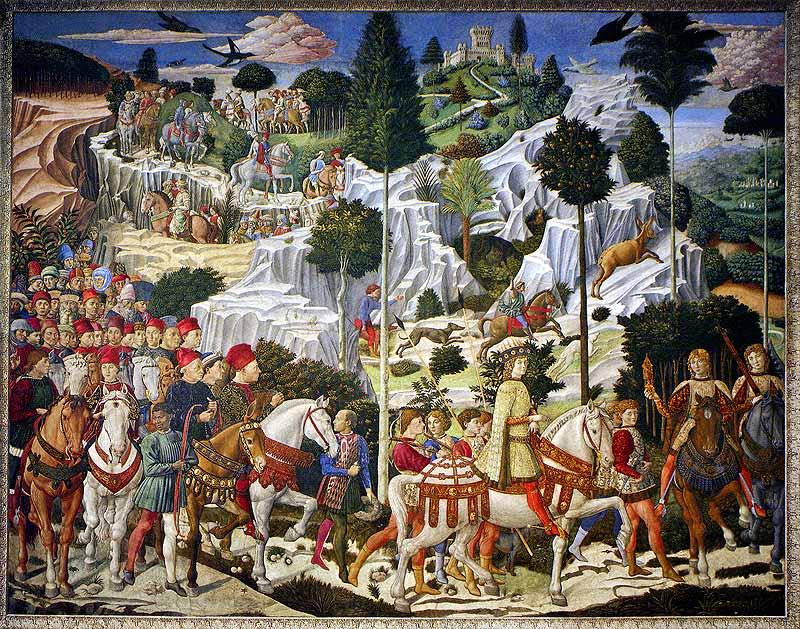It was the fate of Benozzo Gozzoli (c 1422-1497) to be a contemporary of the immortals. A merry journeyman dauber, his talents were overshadowed in his lifetime and are overlooked now. He had a good start in life, working for both Fra Angelico and Ghiberti, but his beautiful frescoes are to be found tucked away in hill towns, innocently crumbling in wayside Tuscan chapels, or locked in the basements of the great museums. In the last 30 years of his life, Gozzoli painted a vast cycle of Old Testament scenes in Pisa's Camposanto. Allied firebombs destroyed all but the odd fragment. Art historians had advised the military what not to target: Gozzoli must have been expendable.
However, there is one wonderful work on which his popularity mainly rests and is a powerful magnet for tourists. It was a commission from Piero dei Medici ("the Gouty"), whose brief period of primacy in Florence left a far shallower imprint than those of his father Cosimo il Vecchio or his son Lorenzo il Magnifico. Gozzoli was invited to decorate a tiny chapel in the family home, now known as the Palazzo Medici-Riccardi, with a panoramic fresco of the Journey of the Magi. The result is a delight. Gozzoli's version of the three kings, completed over a few months in 1459, is at once epic, full of richly liveried trains tailing back through the dramatic Tuscan countryside, and intimate to the point of intrusive. The faces are of course portraits of known Florentines, including the young Lorenzo leading one of the three processions. One of the throng following in his wake is a man who fixes us with a direct gaze and whose red hat bears the words "Opus Benotii": it is a modest portrait of the artist (pictured below).
 Gozzoli's buoyant feel for colourful pageant illuminates a dark and rather poky room, but get in close and you are confronted by his irrepressible zest for detail in all its forms - period, plant and animal. The chapel amounts to a kind of bestiary-cum-menagerie featuring a small encyclopaedia of birdlife as well as an exotic array of hunting animals and beasts of burden, and big and small game - hare, dog and mule, cheetah, camel and antelope.
Gozzoli's buoyant feel for colourful pageant illuminates a dark and rather poky room, but get in close and you are confronted by his irrepressible zest for detail in all its forms - period, plant and animal. The chapel amounts to a kind of bestiary-cum-menagerie featuring a small encyclopaedia of birdlife as well as an exotic array of hunting animals and beasts of burden, and big and small game - hare, dog and mule, cheetah, camel and antelope.
You don't come to the Medici-Riccardi chapel to see artistic history being made. Gozzoli's figures are stiff, his faces jovial, rounded, pretty and for the most part impassive. But if you want to find out how Tuscans dressed themselves and their horses, what their landscapes and cities looked like in the Quattrocento, your best bet is in the Journey of the Magi. We are in the presence of a genre painter whose gift for innovation may have been limited, but whose capacity for good cheer was unbounded.









![SEX MONEY RACE RELIGION [2016] by Gilbert and George. Installation shot of Gilbert & George 21ST CENTURY PICTURES Hayward Gallery](/sites/default/files/styles/thumbnail_125_x_125_/public/mastimages/Gilbert%20%26%20George_%2021ST%20CENTURY%20PICTURES.%20SEX%20MONEY%20RACE%20RELIGION%20%5B2016%5D.%20Photo_%20Mark%20Blower.%20Courtesy%20of%20the%20Gilbert%20%26%20George%20and%20the%20Hayward%20Gallery._0.jpg?itok=3oW-Y84i)





Add comment